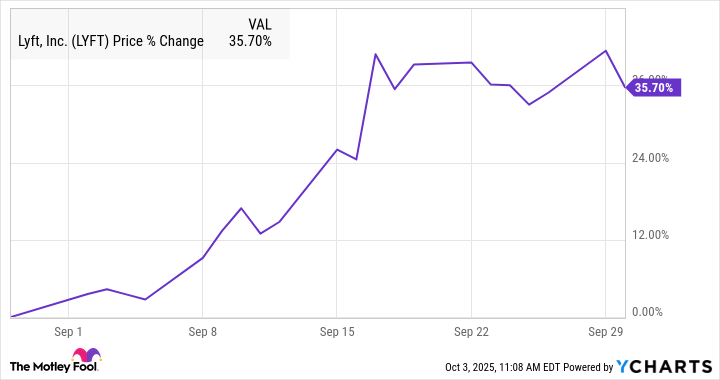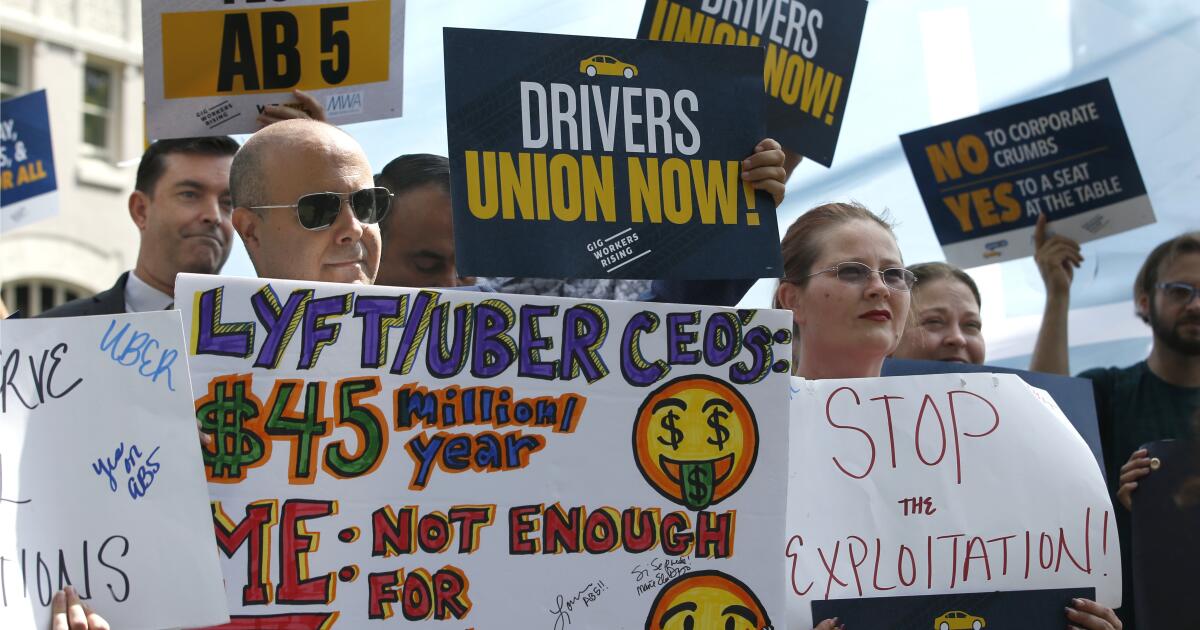SACRAMENTO — Gov. Gavin Newsom and California lawmakers on Friday announced a landmark deal with Uber and Lyft to allow hundreds of thousands of rideshare drivers to unionize and bargain collectively while still being classified as independent contractors.
The compromise between labor unions and the Silicon Valley companies, backed by Newsom, Assembly Speaker Robert Rivas and Senate Pro Tem Mike McGuire, would advance a collective bargaining bill through the Legislature along with a bill backed by Uber and Lyft that would significantly reduce the companies’ insurance requirements.
The deal is a major development in the years-long tussle between organized labor and Silicon Valley over rights for independent contractors.
Labor leaders from Service Employees International Union California, a powerful union that has been working for years to organize app-based drivers, said the deal is the largest expansion of private sector collective bargaining rights in California history.
“Labor and industry sat down together, worked through their differences, and found common ground,” Newsom said in a statement. The agreement, he said, will “empower hundreds of thousands of drivers while making rideshare more affordable for millions of Californians.”
With support from Rivas and McGuire, both bills are expected to sail through the Legislature before the session ends in mid-September. The agreement does not apply to other types of gig workers, including those who deliver food through apps like DoorDash.
The two bills “represent a compromise that lowers costs for riders while creating stronger voices for drivers,” said Ramona Prieto, Uber’s head of public policy for California, in a prepared statement.
The deal marks a new chapter in nearly a decade of tension between technology companies and state lawmakers over the employment status of the tens of thousands of Californians who do gig work for app-based companies.
“This moment has been a long fight for over a decade in the making,” said Tia Orr, the executive director of SEIU California.
After the California Legislature in 2019 rewrote employment law in 2019, clarifying and limiting when businesses can classify workers as independent contractors, Uber and Lyft went to the ballot in California to exempt their drivers.
When California voters passed Proposition 22, the ballot measure funded by Uber and Lyft, in 2020, drivers were classified as independent contractors and, under federal law, do not have the right to organize. Prop. 22 also explicitly barred drivers from collectively bargaining over their compensation, benefits and working conditions.
But SEIU California argued that court decisions over Prop. 22 left an opening for the state Legislature to create a process for drivers to unionize.
Earlier this year, Assemblymember Buffy Wicks (D-Oakland) and Marc Berman (D-Menlo Park) introduced the collective bargaining bill, AB 1340, which Uber and Lyft initially opposed.
The bill allows drivers to negotiate their pay and other terms of their agreements with the companies and exempts workers from the state and federal antitrust laws that normally prohibit collective action by independent contractors.
Under federal law, employees in the U.S. can unionize by holding an election or reaching a voluntary agreement with their employers for a specific union to represent them.
The process for California Uber and Lyft drivers would be somewhat different. The bill says drivers can select a bargaining representative by collecting signatures from at least 10% of active drivers, then petitioning the state’s Public Employment Relations Board for a certification.
That path to collective bargaining mirrors a ballot initiative approved by Massachusetts voters last fall that was also backed by SEIU, which allowed drivers to form a union after collecting signatures from at least 25% of active drivers in the state.
Veena Dubal, a law professor at UC Irvine who studies the effect of technology on workers, said the compromise reached by California lawmakers may not be strong enough to ensure that drivers can reach a fair contract.
The bill does not clarify whether drivers would be protected if they collectively protested or went on strike, she said, and doesn’t require that the companies provide data about wages.
“These are the crux of what makes a union strong and the very, very bottom line of what members need and want,” Dubal said. “That they couldn’t achieve those things — that’s a win for Uber.”
Uber driver Margarita Peñalosa, 45, of Los Angeles, said she realized she needed a union after being temporarily deactivated from the app, and losing three days of income, when a passenger who reeked of marijuana left behind a lingering smell in her car that other riders then complained about.
“That experience made me realize how powerless we can be,” she said. She said she hoped that a collective bargaining process would create a “clear, fair appeals process” for rider complaints.
A Southern California group that counts some 20,000 drivers as members said they had lobbied for provisions to strengthen the bill — including protections that would give drivers the right to strike and more enforcement resources for the state board tasked with overseeing the process — but had been largely shut out of negotiations.
“We were not invited into conversations about this, and we were banging on the door,” said Nicole Moore, president of Rideshare Drivers United.
Representatives from SEIU and Wicks’ office met multiple times with Rideshare Drivers United about their proposals and discussed why some weren’t included, said someone familiar with the negotiations who was not authorized to speak publicly. For example, that person said, strike protections could open up the bill to attack for potentially violating antitrust laws.
“While we always give fair consideration to suggested amendments, not all are ultimately viable,” Wicks said. She added that her office heard from dozens of constituents and advocates over months of public debate, and “any suggestion otherwise is disingenuous.”
Despite the weaknesses in the law, Moore said, she still hopes that it will help, since right now, she said, drivers “have no labor rights and our wages are in the dungeon.”
“We will do what we can with duct tape and a few paper clips and a little extra wax to actually wage a fight,” she said.
The insurance bill, backed by Uber and Lyft and introduced by state Sen. Christopher Cabaldon (D-Yolo), would reduce the amount of insurance that companies like Uber and Lyft are required to provide for rides.
Currently, the companies must carry $1 million in coverage per rideshare driver for accidents caused by other drivers who are uninsured or underinsured. The companies have argued that current insurance requirements are so high that they encourage litigation for insurance payouts and create higher costs for passengers.
The agreement instead calls for $60,000 in uninsured motorist coverage per rideshare driver and $300,000 per accident.
Cabaldon said that the changes would eliminate “outsized insurance requirements that don’t apply to any other forms of transportation, such as taxis, buses, or limos.”



